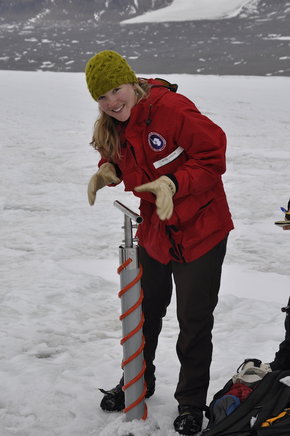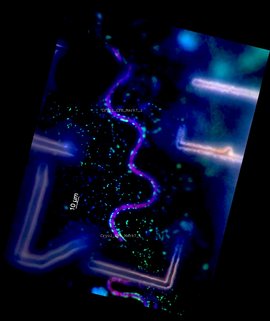Page path:
- Press Office
- Hotspots for biological activity and...
Hotspots for biological activity and carbon cycling on glaciers
Jun 13, 2016
Hotspots for biological activity and carbon cycling on glaciers
Glaciers cover roughly ten percent of Earth’s land surface. They are very important for our climate, as they store large amounts of fresh water and contribute to the reflection of sunlight from the surface of our planet. Glacial melting contributes to sea level rise and reduces reflection, thus increasing global warming.
Life in glacial systems is largely microbial. However, little is known about the role of microorganisms in biogeochemical cycling in these ecosystems. The recent publication takes a close look at how glacial carbon – a food source for bacteria – moves out of the ice and into the environment.
Life in glacial systems is largely microbial. However, little is known about the role of microorganisms in biogeochemical cycling in these ecosystems. The recent publication takes a close look at how glacial carbon – a food source for bacteria – moves out of the ice and into the environment.

The international research team around Heidi Smith from Montana State University (MSU), USA, applied a suite of analytical methods to investigate the microbial community and biological activity on so-called cryoconites in Antarctica. Cryoconites, which are basically dust particles blown onto a glacier, heat up in the sunlight, causing the ice beneath them to melt and forming cylindrical holes. “We found a diverse microbial community associated with cryoconite particles”, says co-author Marcel Kuypers, director at the Max Planck Institute for Marine Microbiology in Bremen. According to Smith and her colleagues, the results indicate that the cryoconite holes provide a matrix for cell arrangements in biofilms that improve nutrient transfer and constitute hotspots of biological activity. “That could increase the accumulation of organic matter on these particles and thus reduce the reflection of sunlight, causing glaciers to melt faster.”
“It’s not that different from a rock on a glacier that absorbs the sun’s energy, heats up and melts the surrounding ice”, adds Christine Foreman, Heidi Smith’s adviser and an associate professor of chemical and biological engineering at MSU. “Heidi’s work is important because she’s among the first to get direct measurements of biofilms on glacier surfaces. We have shown that biofilms transfer and cycle carbon and other nutrients in these systems, and are ecologically advantageous for the survival of organisms in these extreme environments.”
“It’s not that different from a rock on a glacier that absorbs the sun’s energy, heats up and melts the surrounding ice”, adds Christine Foreman, Heidi Smith’s adviser and an associate professor of chemical and biological engineering at MSU. “Heidi’s work is important because she’s among the first to get direct measurements of biofilms on glacier surfaces. We have shown that biofilms transfer and cycle carbon and other nutrients in these systems, and are ecologically advantageous for the survival of organisms in these extreme environments.”
Better understanding the quantities of carbon contained within glaciers, as well as how much carbon is being transferred to other ecosystems, could help scientists better model climate change. Scientists have long known that organic carbon trapped for thousands of years in glaciers serves as a food source for microorganisms and is liberated as the ice melts. However, Smith’s research shows that the fixation of inorganic carbon by microorganisms produces organic carbon that is rapidly used by neighbouring microorganisms.
“Our collaboration with Rachel Foster and Prof. Kuypers at the MPI in Bremen catapulted our research to a new level. While still a student, Heidi Smith spent two months at the MPI working with the NanoSIMS group,” Foreman says. The NanoSIMS (Nanoscale Secondary Ion Mass Spectrometer) allows for the coupling of phylogenetic identity and metabolic function of single cells in mixed microbial communities from the environment. “Applying NanoSIMS technology to an Antarctic glacial system illuminated how the spatial organisation of microbes in biofilms leads to the efficient transfer of nutrients between organisms.”
“Our collaboration with Rachel Foster and Prof. Kuypers at the MPI in Bremen catapulted our research to a new level. While still a student, Heidi Smith spent two months at the MPI working with the NanoSIMS group,” Foreman says. The NanoSIMS (Nanoscale Secondary Ion Mass Spectrometer) allows for the coupling of phylogenetic identity and metabolic function of single cells in mixed microbial communities from the environment. “Applying NanoSIMS technology to an Antarctic glacial system illuminated how the spatial organisation of microbes in biofilms leads to the efficient transfer of nutrients between organisms.”
"I was amazed at the large size of the cyanobacterial filaments and all the attached bacteria since these had been frozen in the glacier. To both visualise and measure how carbon could be exchanged between bacteria and the cyanobacteria using NanoSIMS was both powerful and insightful", co-author Rachel Foster, formerly from MPI Bremen, adds.
“It can be hard to convey the importance of microbes because people can’t see them; but they’re the most abundant organisms on Earth”, Heidi Smith comments. “Microbes are also typically at the base of aquatic food webs, and are likely going to be the first to respond to changes in the ecosystem. In addition to the melt and altering of ocean ecosystems through runoff from the glaciers, there’s also an increase in carbon dioxide, which contributes to the rising temperatures globally.”
“It can be hard to convey the importance of microbes because people can’t see them; but they’re the most abundant organisms on Earth”, Heidi Smith comments. “Microbes are also typically at the base of aquatic food webs, and are likely going to be the first to respond to changes in the ecosystem. In addition to the melt and altering of ocean ecosystems through runoff from the glaciers, there’s also an increase in carbon dioxide, which contributes to the rising temperatures globally.”

Based on a press release by Montana State University.
Original publication
Biofilms on glacial surfaces: hotspots for biological activity
Heidi J Smith, Amber Schmit, Rachel Foster, Sten Littman, Marcel MM Kuypers, Christine M Foreman. npj Biofilms and Microbiomes 2, 16008
DOI: doi:10.1038/npjbiofilms.2016.8
Contact
Heidi Smith, [Bitte aktivieren Sie Javascript]
Marcel Kuypers, [Bitte aktivieren Sie Javascript]
or the press office
Fanni Aspetsberger, Manfred Schlösser
[Bitte aktivieren Sie Javascript]
Original publication
Biofilms on glacial surfaces: hotspots for biological activity
Heidi J Smith, Amber Schmit, Rachel Foster, Sten Littman, Marcel MM Kuypers, Christine M Foreman. npj Biofilms and Microbiomes 2, 16008
DOI: doi:10.1038/npjbiofilms.2016.8
Contact
Heidi Smith, [Bitte aktivieren Sie Javascript]
Marcel Kuypers, [Bitte aktivieren Sie Javascript]
or the press office
Fanni Aspetsberger, Manfred Schlösser
[Bitte aktivieren Sie Javascript]